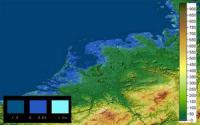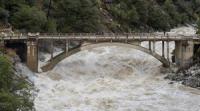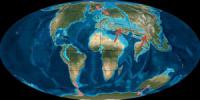-
Climate change will displace millions in coming decades. Nations should prepare now to help them
By the middle of this century, experts estimate that climate change is likely to displace between 150 and 300 million people. If this group formed a country, it would be the fourth-largest in the world, with a population nearly as large as that of the United States. Yet neither individual countries nor the global community are completely prepared to support a whole new class of “climate migrants.” The scale of this challenge is unlike anything humanity has ever faced. By midcentury, climate change is likely to uproot far more people than the Second World War, which displaced some 60 million across Europe, or the Partition of India, which affected approximately 15 million. The migration crisis that has gripped Europe since 2015 has involved something over one million refugees and migrants. It is daunting to envision much larger flows of people, but that is why the global community should start doing so now.
-
-
Climate change will displace millions of people. Where will they go?

The 1951 Refugee Convention defines a protected refugee as someone who leaves his or her home country due to racial, religious, or social persecution, or reasonable fear of such persecution. These refugees have the right to seek asylum and protection from participating members of the United Nations (though these countries are not obligated to take them in). However, people displaced by climate change do not fit this definition. At the international level, there is no legal mechanism in place to protect climate migrants’ rights and to ensure assistance from other countries. For climate relocation to work, governments need to care and commit to international responsibility and burden-sharing. However, in the current global political context of fear of terrorism, an increased refugee influx into Europe, and an overall rise of xenophobia, countries are more likely to opt for stricter policies on cross-border migration.
-
-
Virgin Islands re-establishes disaster early warning system
The cabinet of the Virgin Islands has approved the expenditure of $442,000 to re-establish the National Early Warning System. Some of the networks were established as far back as 1979 and have been used to provide immediate warning and notification to persons throughout the territory. As a result of the National Early Warning Program, the Islands’ Department of Disaster Management (DDM) was able to apply for and receive Tsunami Ready Recognition in 2014 and this was renewed in June 2017.
-
-
Learning from Mexico's earthquake early warning system
In the company of only Japan and Taiwan, Mexico is one of few countries equipped with a seismic warning system that currently broadcasts publicly. Mexico has been broadcasting in a public regional capacity since 1993 via the Mexico Seismic Warning System, which currently has more than 90 sensors in central and southern Mexico. Although no one can reliably predict earthquakes, today’s technology is now advanced enough to rapidly detect seismic waves as an earthquake begins and send alerts to surrounding areas before damaging shaking arrives.
-
-
Hawaii’s missile alert gaffe: why good human-machine design is critical
It’s an unfortunate reality that we need to prepare for national emergencies due to war or natural disasters. Civil defense organizations, set up to coordinate and respond to such emergencies, are an important part of any modern state. Such entities play a critical role in terms of triggering alerts, coordinating response across law enforcement and emergency services, disseminating information and aiding response efforts to minimize impact and restore order. Clearly, they are important systems for alerting nations to risks when disaster strikes. But such systems can go wrong. Our interaction with technology is becoming more and more complex. Early warning systems are very welcome, but the Hawaii mishap serves as an opportunity for a radical redesign, with a better understanding of their impact on the population. At a time when the world is increasingly uncertain and our dependence on technology is so high, a redesign of poor warning systems is critical.
-
-
Long-term warming trend continued in 2017: NASA, NOAA
Earth’s global surface temperatures in 2017 ranked as the second warmest since reliable instrumental records began in 1880, according to an analysis by NASA. Continuing the planet’s long-term warming trend, globally averaged temperatures in 2017 were 1.62 degrees Fahrenheit (0.90 degrees Celsius) warmer than the 1951 to 1980 mean. The planet’s average surface temperature has risen about 2 degrees Fahrenheit (a little more than 1 degree Celsius) during the last century or so, a change driven largely by increased carbon dioxide and other human-made emissions into the atmosphere. Last year was the third consecutive year in which global temperatures were more than 1.8 degrees Fahrenheit (1 degree Celsius) above late nineteenth-century levels.
-
-
2018: Critical period of intensified risks
The Global Risks Report 2018, published this week by the World Economic Forum cautions that we are struggling to keep up with the accelerating pace of change. It highlights numerous areas in which we are pushing systems to the brink, from extinction-level rates of biodiversity loss to mounting concerns about the possibility of new wars. The reports says that the structural and interconnected nature of risks in 2018 threatens the very system on which societies, economies, and international relations are based – but that the positive economic outlook gives leaders the opportunity to tackle systemic fragility.
-
-
Post-disaster reconstruction divides society
In 2004, a tsunami devastated much of the Indonesian city of Banda Aceh. An estimated 160,000 people were killed. In the years that followed, aid providers rebuilt homes on the same plots that had been completely destroyed by the tsunami, in order to avoid displacing the residents. In doing so, they were acting in accordance with a humanitarian principle that comes into play after natural disasters, namely to help survivors to return to their previous places of residence whenever possible. Yet in Banda Aceh, many tsunami survivors preferred to move inland instead, leading to a price premium for properties farther from the coast and socio-economic segregation. The unfortunate result is that lower-income residents are now disproportionately exposed to coastal hazards.
-
-
2017 saw the highest ever sea level on the Dutch coast

The average sea level measured on the Dutch coast was higher than ever before in 2017. The Dutch sea level, the averaged measurements from six tide stations, rose to 11 cm above Normal Amsterdam Water Level (NAP in Dutch). The last highest measurement was in 2007, when the average sea level was 9 cm above NAP. The fact that the sea level was higher last year does not mean that the sea level is now rising faster. At present, the sea level on the Dutch coast is rising by 20 cm every century.
-
-
Tracing how disaster impacts escalate to help improve emergency responses
Naturally occurring extreme space weather events or man-made cyber security attacks affect critical infrastructure through shared points of vulnerability, causing disasters to cascade into scenarios that threaten life and the global economy. Mapping common pathways along which the effects of natural and man-made disasters travel allows more flexible and resilient responses in the future, according to UCL researchers.
-
-
River flood risks increase around the globe under future warming

Rainfall changes caused by global warming will increase river flood risks across the globe. Already today, fluvial floods are among the most common and devastating natural disasters. Scientists have now calculated the required increase in flood protection until the 2040s worldwide, breaking it down to single regions and cities. They find that the need for adaptation is greatest in the United States, parts of India and Africa, Indonesia, and in Central Europe including Germany. Inaction would expose many millions of people to severe flooding.
-
-
Climate change changing Earth’s landscape

Climate change will replace land use change as the major driver of changes in Earth’s biosphere in the twenty-first century if greenhouse gas emissions aren’t curbed, new research suggests. Historically, human land use change, like urban development and agricultural expansion, has been the primary cause of anthropogenic ecosystem change. But now, due to rising greenhouse gas levels, climate change has become a growing threat to ecosystems. The rapid pace of climate change is making it difficult for species to adapt to changes in temperature, water cycles, and other environmental conditions that affect life on Earth.
-
-
Two things matter when bouncing back from natural disasters
Disaster happens. But solid local leadership combined with the right outside partners can mitigate the fallout and save lives. ‘The national actors who are there, whether they are firefighters, first responders, or people working on disaster and emergency preparedness policy — they are the ones who drive the conversation,” says one expert. But the second part of developing resiliency in the face of a disaster, she adds, is having international players acting as a catalyst. “This is central to the actual activities that you’re delivering.”
-
-
Hurricanes and earthquakes -- one may predict the other
When three major hurricanes and just as many powerful earthquakes happen at around the same time, as they did in 2017, many wonder if they are connected. While the 2017 hurricanes and the earthquakes in Mexico are likely not connected, geophysicist Shimon Wdowinski believes there could be a correlation between hurricanes and the earthquakes that come much later.
-
-
2017 climate, weather disasters in U.S. totaling $306 billion — a new record
2017 will be remembered as a year of extremes for the United States as floods, tornadoes, hurricanes, drought, fires, and freezes claimed hundreds of lives and visited economic hardship upon the nation. The average U.S. temperature in 2017 was 54.6 degrees F (2.6 degrees F above average), making 2017 third warmest year in 123 years of record-keeping. The five warmest years on record for the United States all have occurred since 2006. In 2017, the United States experienced 16 weather and climate disasters each with losses exceeding $1 billion, totaling approximately $306 billion — a new U.S. record. Far more tragic was the human toll. At least 362 people died and many more were injured during the course of these disasters.
-
More headlines
The long view
Trump Aims to Shut Down State Climate Policies
President Donald Trump has launched an all-out legal attack on states’ authority to set climate change policy. Climate-focused state leaders say his administration has no legal basis to unravel their efforts.
